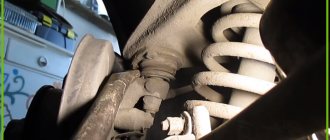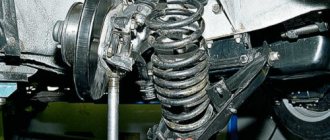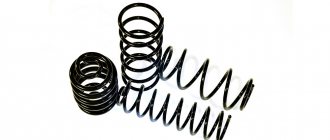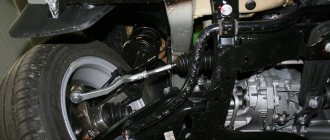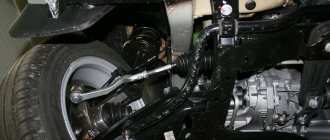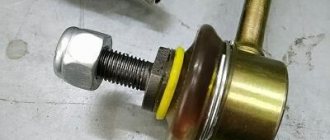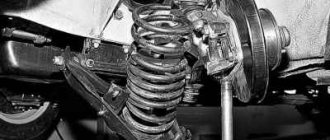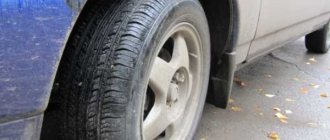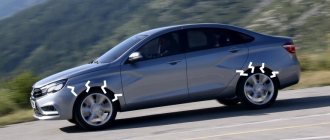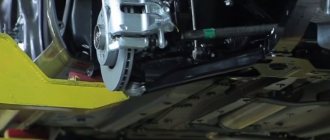The role of ball joints in the front chassis of most vehicles is fundamental. The ball joint provides the suspension with a stable position relative to the road and allows the steering knuckles to maneuver in terms of changing the trajectory. The part was invented about 40 years ago in Italy. Its creator is considered to be a Fiat engineer. Since then, this product has undergone almost no global design changes. These supports are also present in the design of the chassis of the practical station wagon of Russian origin Lada Largus.
Parameters of supports for Largus
A ball joint has a basic structural unit - its load-bearing element - a special metal pin. Its lower part rotates in a hemisphere, and the upper end of this component is connected to the steering axle bracket. The hemisphere is located in the support body and rotates in a polymer shell, which is designed to dampen vibrations and prevent mutual friction of the metal surfaces of the part (hemisphere and body).
The product body itself is pressed into the suspension arm cage. To prevent dirt and other debris from getting into the working element (hemisphere), there is a rubber boot between the finger and the body.
Regarding Lada Largus. Note that on versions of the model produced before 2013, the ball joint had a pin with a groove and a diameter of 16 mm.
On modern modifications of the station wagon, the support pins have a pin increased to 18 mm in diameter, which has a side groove.
Due to their purpose, supports endure increased loads during operation, so the requirements for their reliability and quality are very high. For example, a finger must withstand the applied external force aimed at tearing it out of the body, reaching 5 tons.
To guide manufacturers in terms of quality indicators of supports, GOST 52433-2005 “Ball joints” was specially developed and implemented. Technical requirements and test methods." The provisions of this regulation must be followed not only by Russian, but also by foreign manufacturers.
Today's spare parts market will delight you with a wide range of support offers, each of which has its own catalog number, among which the following brands are the most profitable and confidence-inspiring:
- "Febi", "Ruville", "Mapco" and "Meyle" (all Germany);
- "Monroe" and "Delphi" (both USA);
- "Tork avto" (Türkiye).
The price of these products can vary by 40% or more, although the quality indicators will be approximately the same level. Here, the particular choice includes the personal preferences of the particular owner of the Lada Largus..
Article number and price for the original ball joint
On the Lada Largus car, two types of ball joints are used. Until June 2013, the knot had a finger with a diameter of 16 mm. An annular groove was made on the support. The article number for the old-style ball is 401604793R. The price of the part ranges from 680 to 850 rubles.
In the 2014 model range, new types of supports began to be used. The diameter of their finger was increased to 18 mm. The groove has also changed. It became lateral, which, according to the designers, increased the reliability of the unit. The catalog number of the new ball is 40160-2523R. The cost of the support is 500-1400 rubles.
Despite the fact that ball joints of different years of manufacture are successfully pressed into seats instead of each other, experienced car owners do not recommend doing this. Using a “foreign” support may cause a knock in the suspension, and a number of difficulties will arise during installation.
The balls are fixed using a bolt with an increased diameter inside. The old and new type support mounts are not interchangeable. When purchasing an unsuitable unit, car owners have to bore a groove for the bolt, which does not have the best effect on the reliability and safety of the suspension.
Malfunctions, inspection and possibility of repair
Among the main reasons for premature wear of bearings is the ingress of dirt and abrasives into the hinge body. This option is possible if the protective boot breaks. The initial stage of this situation is accompanied by a suggestive creaking of the finger. There are also less difficulties when turning and unauthorized changes in the trajectory of the Lada Largus car, which runs in a straight line. This situation involves checking the condition of the supports and, if a defect is detected, urgent replacement.
It is possible to diagnose the part yourself. For this purpose, we hang out the required side of the car. We check the play of the steering knuckle by applying force to the hinge. We use a suitable mount. A worn-out product will immediately make itself known with a characteristic clicking sound inside the body of the part. If there is no play, and there are places where the shell is torn on the boot, then such a support should also be replaced, since it has very little time left to “live”.
Sometimes owners of Lada Largus. they resort not to replacing supports, but to their repair (so-called restoration). This work is very labor-intensive and requires the use of special equipment (press and other devices). You will also need to acquire polymer materials that will be integrated into the body of the product. We recommend entrusting work of this nature to professionals who have experience and equipment, although there are plenty of videos on this subject on the Internet.
DRL Largus
Lada Largus or Lada Vesta
Let us remind you that the supports are one of the parts that are responsible for safety, so the best measure would still be to replace the ball joint, preferably with the original version.
How to replace: step-by-step guide
The process of replacing ball joints occurs with the front wheels of the car suspended. It is most convenient to perform this work on a lift in a car repair shop.
There are two main ways to replace a ball joint:
- Replacement of the front suspension arm assembly,
- Replace only the damaged ball joint.
If the front suspension arms of your car are not damaged, and the rubber bushings and silent blocks do not need to be replaced, and besides, you have no desire to overpay, you can absolutely safely change only the ball joints. Therefore, we will further consider the second option.
- After we have removed the front wheel from the side we need, we remove the caliper.
Pressing out the ball joint
It should be noted that if you nevertheless find any defects or damage on the front suspension arm itself, then it is necessary to replace it along with the ball joint.
How to change ball joints on a Renault Logan: video
I would like to draw your attention to one more thing. After replacing the ball joints, make sure that the tabs on the lock washer, which fits onto the ball joint nut and are bent onto the knuckle, are bent. If this is not done, then over time the nut may unscrew, and this is fraught with the risk that the ball pin may pop out during operation of the car. And at the most inopportune moment. We need to keep an eye on this.
Why change and how to choose?
Significant wear of the support suggests the presence of a large gap formed by the filler of the product body and directly by the hemisphere of the pin. This condition of the part is characterized by a knocking sound that occurs when driving over uneven surfaces. If the repair is delayed, the finger may spontaneously release from the housing, which will lead to an accident.
Do not forget to regularly inspect the integrity of the support boots for damage. Over time, cracks form on the rubber surface, which develop into tears. It is also very important to check for play in the pin, because early diagnosis and replacement of the ball joint will avoid all sorts of unpleasant situations.
We recommend choosing original supports for Lada Largus. Refurbished analogues should be taken with a grain of salt. Here, the low price should not become a temptation, since the owner needs to think about the safety of both his own and those around him. When choosing, take into account the year of manufacture of your car, since the pins have differences in diameter.
Diagnostics of the ball joint condition
Symptoms of the need to pay attention to the Largus ball joint are:
- there was a need to apply additional force when turning the steering wheel;
- driving over bumps, for example, a speed bump, is accompanied by a knocking sound from the front suspension;
- Uneven tire wear was detected;
- entering a turn is accompanied by extraneous sounds coming from the wheel arches;
- the steering wheel turns with a creaking or grinding sound;
- the car has become less obedient when entering a turn;
- When driving over bumps, controllability partially decreased and the car became unstable.
If you have the above symptoms, it is recommended to use the following algorithm for finding a ball fault.
- Hang it in front of Largus.
- Take the tire from above and below.
- Check that there is no play. To do this, you need to shake the wheel in a vertical plane. It should be borne in mind that the cause of movement may be not only the ball joint, but also worn steering tips or stabilizer links.
The main load-bearing element of the ball joint is the pin. It is made of high carbon steel. On one side of the finger there is a sphere, which is located in a metal case. It is filled with polymer or grease. To prevent moisture, dirt and dust from entering, a protective cuff is placed on top.
Abrasive particles and water pass through the boot freely if it is damaged. The sphere and its seat are subject to intense wear, and the lubricant dilutes and ceases to perform its functions
Therefore, when diagnosing a ball, it is important to pay attention to the condition of the boot. If cracks, punctures, holes or other holes are found, the support must be replaced.
Replacing the ball joint
Replacing the ball joint can be done independently, but this labor-intensive operation will require high-quality tools and accessories. The instructions will also not be superfluous and will allow you to correctly carry out the entire list of manipulations.
- We hang the LADA Largus car or install it over a pit or overpass.
- We remove the wheel from the side we need (if there is a need to lift the car with a jack, then do this).
- Loosen the tightening torque of the bolt holding the transverse arm to the subframe.
- Now we disconnect the fastening of the ball pin to the steering axle.
- Next, you will need to spread the cheeks of the steering knuckle bracket to release the LADA Largus support pin. A thin chisel or a powerful screwdriver will work here.
- We lower the lever together with the support.
- We finally unscrew the fastening of the lever to the subframe and remove the product.
- We begin to press out the worn ball from the lever bracket. First you will need to remove the retaining ring. Here you will need a press. If it is missing, then you will have to do “creativity”, where a hammer and a mandrel will become your assistants.
- We act carefully.
- We prepare a new support and clean the seat from dirt. We press it into the opening of the lever until a groove appears on the reverse side for mounting the locking ring.
- After putting the stopper on, apply the lubricant included with the part into the hinge body.
- We put on the boot, which we also secure with rings.
- We install the assembled lever, but do not tighten the fasteners.
- We reinstall all dismantled components.
- We load the suspension of the LADA Largus car by placing it on the wheels. We perform the final tightening of the fastening components of the lever.
The ball joint replacement is complete. A video can also help you with this matter.
Front suspension arm ball joint - removal and installation (repressing)
Attention. The front suspension arm ball joint can only be replaced once. For this purpose, ball joints from spare parts are marked with the letter “R” and are equipped with a locking spring 4, Figure 6-1. The ball joint, without retaining spring, is a standard part and can be replaced.
Part Numbers: Replacement Ball Joint (R), Arm/Ball Assembly
Note: For test results of ball joints from different manufacturers, see the end of the article.
The ball joint with retaining spring is a replacement part and cannot be replaced. In addition, it should be borne in mind that by the time the second set of ball joints (R) wears out, the silent blocks of the lever will already be worn out. If it is necessary to replace the ball joint again, replace the front suspension arm assembly.
| Figure 6-1 - Distinctive features of the ball joint supplied as spare parts: 1 - marking of the ball joint supplied as spare parts “R”; 2 — ball joint; 3 — front suspension arm; 4 - locking spring |
Removal
Jack up or place the vehicle on a two-post lift, apply the parking brake and turn off the ignition.
Remove the front wheel
Remove the front suspension arm. (see here)
Clean the front suspension arm from dirt (with a metal brush).
If there is no special equipment for pressing out
Using a powerful slotted screwdriver, evenly (from different sides) pry the support body under the shoulder and, leaning on the edge of the lever...
...press the ball joint out of the hole in the lever.
We inspect the lever eye - there should be no cracks or breaks around the hole.
Before pressing in the new ball joint, thoroughly clean the seating surface of the lever hole from dirt and corrosion.
Place a tool head or a piece of pipe of suitable diameter under the lever and insert a new ball joint into the hole. Applying blows with a hammer to the mandrel (you can use a tool head) resting on the shoulder of the support body, we press the support into the hole of the lever until it stops.
Attention. The lower control arm ball joint is supplied in a protective case. Remove the cover only after pressing the ball joint into the front suspension arm and installing the lock spring 4, Figure 6-1.
If special equipment is available
Remove the ball joint boot clamps and the boot (flat head screwdriver).
Place a stop marked “D1” on the press table, install the front suspension arm on the stop, install a mandrel marked “D2” on the ball joint body for pressing out, and press the ball joint out of the front suspension arm (press, stop marked “D1” and mandrel marked “D2” for pressing out from the Tav. 1929 set).
Installation
Place a stop marked “R1” on the press table, install the front suspension lever on the stop, install a new ball joint in the hole in the lever, install a mandrel marked “R2” on the body of the ball joint for pressing and press the ball joint into the front suspension arm (press, stop marked “R1” and mandrel marked “R2” for pressing out from set Tav. 1929).
Other operations
Install the retaining spring into the groove of the ball joint, using the protective boot as a guide.
Remove the transport cover from the ball joint.
Install the front suspension arm.
Install the front wheel
Check and, if necessary, adjust the alignment angles of the front wheels
ADDITION
Results of comparative tests of the strength of ball joints from various manufacturers
Tests were carried out by Za Rulem magazine in 2021. The participants were ball joints suitable for Lada Largus, Renault Sandero and Logan cars.
All products met the standard, but the difference in results is double.
Results of spectral analysis of ball joint pin material
| Brand | steel grade |
| Kroner | steel 40X |
| Lada Standard | steel 45 |
| Renault group | steel 45 |
| Sasic | steel 40Х |
| Sevi | steel 40Х |
| TRT | steel 38ХГМ |
Results of measurements of the hardness of the ball surfaces of the supports
| Brand | Hardness, HRC (three points) | ||
| Kroner | 28 | 28 | 28,5 |
| Lada Standard | 32 | 32.5 | 32,5 |
| Renault group | 32 | 34 | 34 |
| Sasic | 28 | 28 | 24 |
| Sevi | 31 | 31 | 29 |
| TRT | 24 | 23,5 | 26 |
Results of measuring the surface roughness of balls and pins of ball joints
| Brand | Roughness (Ra), µm | |
| Finger surface | Ball surface | |
| Kroner | 2.30 | 0.53 |
| Lada Standard | 1.34 | 0.28 |
| Renault group | 1.79 | 0.25 |
| Sasic | 1.62 | 0.24 |
| Sevi | 0,93 | 0.15 |
| TRT | 0.92 | 0.19 |
Results of measurements of pullout and extrusion forces of ball joints
| Brand | Ball diameter mm | Breakout force kgf (standard -1500) | Extrusion force kgf (standard - 2100) |
| Kroner | 25 | 4210 | 3520 |
| Lada Standard | 25 | 2500 | 3300 |
| Renault group | 25 | 2180 | 2700 |
| Sasic | 25 | 4240 | 3060 |
| Sevi | 25 | 2300 | 3100 |
| TRT | 25 | 4180 | 5100 |
General view of balls with brief results
Kroner (K330120) , country not specified Retaining ring - for expansion pliers. The boot fits into the lever hole with difficulty. The fit of the support is tight; in the freezer the elastic band fell apart at -50°C - this is not good. We cannot recommend
Lada Standard (LS000-2904192-81) , Russia Retaining ring - for expansion pliers. The boot fits freely into the lever. The tension in the support fit is average. The product was not afraid of fifty degrees of frost. The result is second place in our tests. We recommend
Renault group (41 60 25 23R) , France The most expensive product. The retaining ring is thin and wire. The boot fits into the lever freely. Landing of the support with medium force. The power reserve is the smallest. At a temperature of -40°C, the anther fell into pieces. We cannot recommend it.
Note: The product sold under the name “Renault group” with code 41 60 25 23R cannot be classified as original spare parts. The Renault representative informed us that neither the packaging nor the label corresponded to the original ones. In addition, the reference of original Renault spare parts consists of ten characters, not nine. At the same time, Renault does not produce a ball with a side groove: the original products have a groove machined across the entire surface of the cylindrical part of the pin.
Sasic (7574013) , EU The boot easily fits into the hole in the lever, and the support is fixed with a thin wire and an ax ring. In the freezer at -50°C, the anther lost its integrity. We cannot recommend
Sevi (7013-4192 ), Russia The retaining ring is wire, frankly “frail”. The boot fits easily into the hole in the lever. The tension when landing the support is average. The product passed the frost test. The result is third place. We recommend
TRT (RS8018) , South Korea The cheapest support. The locking ring is powerful - for pliers. The boot squeezes into the lever. The fixation in the hole is tight. The low roughness of the ball and significant extrusion forces indicate an increased service life of the product. First place! We recommend
No obvious defects were found during mechanical tests - and this is good news. However, thermal tests eliminated half of the participants: only Lada, Sevi and TRT remained. It was these ball joints that made it into the top three. We award the absolute victory to the TRT product: at the lowest price in the sample, it promises the highest resource. And the weak wire retaining ring of the Sevi pushes it to the third level, giving way to second place to the Lada Standard product.
Video
